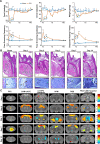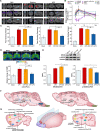Spatiotemporal dynamics of brain function during the natural course in a dental pulp injury model
- PMID: 35304628
- PMCID: PMC9206688
- DOI: 10.1007/s00259-022-05764-2
Spatiotemporal dynamics of brain function during the natural course in a dental pulp injury model
Abstract
Purpose: Toothache, a common disorder afflicting most people, shows distinct features at different clinical stages. This study aimed to depict metabolic changes in brain and investigate the potential mechanism involved in the aberrant affective behaviors during the natural process of toothache.
Methods: We investigated the spatiotemporal patterns of brain function during the natural course of toothache in a rat model of dental pulp injury (DPI) by using positron emission tomography (PET).
Results: Glucose metabolism peaked on the 3rd day and gradually decreased in several brain regions after DPI, which was in line with the behavioral and histological results. PET imaging showed that visual pathway was involved in the regulation of toothache. Meanwhile, the process of emotional regulation underlying toothache was mediated by N-methyl-D-aspartic receptor subunit 2B (NR2B) in the caudal anterior cingulate cortex (cACC).
Conclusion: Our results revealed the spatiotemporal neurofunctional patterns during toothache process and preliminarily elucidated the role of NR2B in cACC in the regulation of toothache-related affective behaviors.
Keywords: Caudal anterior cingulate cortex (cACC); Dental pulp injury (DPI); Positron emission tomography (PET); Toothache.
© 2022. The Author(s).
Conflict of interest statement
The authors declare no competing interests.
Figures


Similar articles
-
Meta-analysis on brain representation of experimental dental pain.J Dent Res. 2014 Feb;93(2):126-33. doi: 10.1177/0022034513512654. Epub 2013 Nov 12. J Dent Res. 2014. PMID: 24221915
-
Paradoxical surrogate markers of dental injury-induced pain in the mouse.Pain. 2013 Aug;154(8):1358-67. doi: 10.1016/j.pain.2013.04.018. Epub 2013 Apr 11. Pain. 2013. PMID: 23719574 Free PMC article.
-
DENTAL PULP HEMOGRAM.J Dent Res. 1965 Jul-Aug;44:678-82. doi: 10.1177/00220345650440041301. J Dent Res. 1965. PMID: 14321401 No abstract available.
-
Neuropeptides in dental pulp: the silent protagonists.J Endod. 2008 Jul;34(7):773-88. doi: 10.1016/j.joen.2008.03.010. J Endod. 2008. PMID: 18570980 Review.
-
Considerations and treatment of direct and indirect pulp-capping.Dent Clin North Am. 1985 Apr;29(2):251-9. Dent Clin North Am. 1985. PMID: 3888697 Review.
Cited by
-
Fractional amplitude of low-frequency fluctuation changes of specific cerebral regions in patients with toothache: A functional magnetic resonance imaging study.Brain Behav. 2023 Apr;13(4):e2937. doi: 10.1002/brb3.2937. Epub 2023 Mar 19. Brain Behav. 2023. PMID: 36934446 Free PMC article.
-
State-of-the-art of nuclear medicine and molecular imaging in China: after the first 66 years (1956-2022).Eur J Nucl Med Mol Imaging. 2022 Jul;49(8):2455-2461. doi: 10.1007/s00259-022-05856-z. Eur J Nucl Med Mol Imaging. 2022. PMID: 35665836 Free PMC article. No abstract available.
-
Phenomic Imaging.Phenomics. 2023 Nov 3;3(6):597-612. doi: 10.1007/s43657-023-00128-8. eCollection 2023 Dec. Phenomics. 2023. PMID: 38223684 Free PMC article. Review.
References
-
- Clark GT. Persistent orodental pain, atypical odontalgia, and phantom tooth pain: when are they neuropathic disorders? J Calif Dent Assoc. 2006;34(8):599–609. - PubMed
MeSH terms
LinkOut - more resources
Full Text Sources

